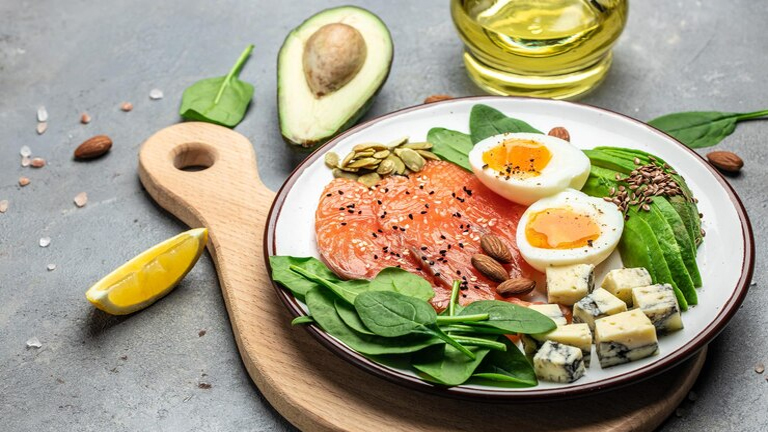The ketogenic diet (keto diet) is a low-carb, high-fat eating plan designed to shift your body into a metabolic state called ketosis. In ketosis, your body burns fat for fuel instead of carbohydrates, leading to weight loss and other health benefits.
This guide covers everything you need to know about the keto diet, including its benefits, foods to eat and avoid, potential side effects, and tips for success.
How Does the Keto Diet Work?
The keto diet drastically reduces carbohydrate intake (typically to 20-50 grams per day) and replaces it with healthy fats and moderate protein. This shift forces your body to enter ketosis, where it produces ketones from fat to use as energy instead of glucose.
Macronutrient Breakdown on Keto:
-
70-80% Fat (avocados, olive oil, nuts, butter)
-
20-25% Protein (meat, fish, eggs)
-
5-10% Carbs (leafy greens, low-carb vegetables)
Health Benefits of the Keto Diet
1. Promotes Weight Loss
By burning fat for energy, the keto diet helps reduce body fat and suppress appetite, leading to sustainable weight loss.
2. Improves Blood Sugar & Insulin Sensitivity
Studies show that keto can help lower blood sugar levels and improve insulin resistance, making it beneficial for type 2 diabetes management.
3. Boosts Brain Function
Ketones provide a steady energy source for the brain, potentially improving focus, mental clarity, and even reducing symptoms of epilepsy and Alzheimer’s.
4. Supports Heart Health
When done correctly (with healthy fats), keto may improve cholesterol levels by increasing HDL (good cholesterol) and lowering triglycerides.
5. May Reduce Inflammation
A low-carb, high-fat diet can decrease inflammation, which is linked to chronic diseases like arthritis and metabolic syndrome.
Keto-Friendly Foods to Eat
To stay in ketosis, focus on these foods:
Healthy Fats:
-
Avocados
-
Olive oil, coconut oil
-
Butter & ghee
-
Nuts & seeds
Proteins:
-
Meat (beef, chicken, pork)
-
Fatty fish (salmon, tuna)
-
Eggs
Low-Carb Vegetables:
-
Spinach, kale, lettuce
-
Broccoli, cauliflower
-
Zucchini, asparagus
Dairy (in moderation):
-
Cheese (cheddar, mozzarella)
-
Heavy cream
-
Greek yogurt (unsweetened)
Foods to Avoid on Keto
To stay in ketosis, avoid high-carb foods, including:
-
Grains (bread, pasta, rice)
-
Sugary foods (soda, candy, desserts)
-
Starchy vegetables (potatoes, corn)
-
Processed foods (chips, fast food)
-
Most fruits (except berries in moderation)
Potential Side Effects & How to Manage Them
When starting keto, some people experience the “keto flu,” which includes:
-
Fatigue
-
Headaches
-
Dizziness
-
Digestive issues
How to Reduce Keto Flu Symptoms: Keto Diet
✔ Stay hydrated (drink plenty of water & electrolytes)
✔ Increase salt intake (helps with electrolyte balance)
✔ Ease into keto (gradually reduce carbs instead of cutting them suddenly)
Tips for Keto Diet Success
-
Meal Prep: Plan meals ahead to avoid carb-heavy temptations.
-
Track Macros: Use apps like MyFitnessPal or Carb Manager to stay on track.
-
Stay Consistent: It takes time for your body to adapt—stick with it for at least a few weeks.
-
Exercise: Combine keto with strength training or cardio for better results.
-
Listen to Your Body: Adjust fat and protein intake based on energy levels.
Keto Diet Quick Reference Table
| Category | Details |
|---|---|
| What is Keto? | A low-carb, high-fat diet that puts the body into ketosis, burning fat for energy instead of carbs. |
| Macronutrient Ratio | – 70-80% Fat – 20-25% Protein – 5-10% Carbs (20-50g net carbs/day) |
| Benefits | – Weight loss – Improved blood sugar control – Enhanced mental clarity – Reduced inflammation – Better heart health (with healthy fats) |
| Foods to Eat | – Fats: Avocado, olive oil, nuts, butter – Proteins: Meat, fish, eggs – Low-carb veggies: Spinach, broccoli, cauliflower – Dairy (moderate): Cheese, heavy cream |
| Foods to Avoid | – Sugary foods (soda, candy) – Grains (bread, pasta) – Starchy veggies (potatoes, corn) – Most fruits (except berries) |
| Side Effects | “Keto flu” (fatigue, headaches) – Combat with electrolytes, hydration, and gradual carb reduction. |
| Tips for Success | – Track macros – Meal prep – Stay hydrated – Exercise – Be patient (takes 2-4 weeks to adapt) |
| Who Should Avoid? | People with kidney disease, pancreatitis, or pregnant/breastfeeding women (consult a doctor first). |
Is the Keto Diet Right for You? Keto Diet
While the keto diet offers many benefits, it may not be suitable for everyone. Consult a doctor before starting if you have:
-
Kidney disease
-
Pancreatic disorders
-
Pregnancy or breastfeeding
Final Thoughts Keto Diet
The ketogenic diet is a powerful tool for weight loss, blood sugar control, and overall health. By focusing on healthy fats, moderate protein, and low-carb foods, you can achieve ketosis and experience its benefits.
Ready to start keto? Plan your meals, stay hydrated, and be patient—your body will thank you!


